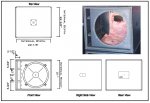I'm going to be auditioning some of the B&C designs from their website with a carpenter/audio engineer buddy of mine. This guy is great with all things wood and is very knowledgable about lumber sources. I told him the plans called for 3/4" (18mm) Birch Ply. He tells me that there are several grades to choose from and that they numbered or lettered that show their level of quality.
What are you guys using?
I'm going to be starting with a modified version of the S18BN Single 18" cabinet. The real mod will be to loose the bottom angle cuts where the castors go and build some dollies for transport. We're also going to add some battons to some of the edges to increase the strength. Essentially where we gain volume, we are going to lose with the extra bracing.
i currently have the drivers in some OAP LF118 boxes and I'm getting some port choking so I need to try to something else.
What are you guys using?
I'm going to be starting with a modified version of the S18BN Single 18" cabinet. The real mod will be to loose the bottom angle cuts where the castors go and build some dollies for transport. We're also going to add some battons to some of the edges to increase the strength. Essentially where we gain volume, we are going to lose with the extra bracing.
i currently have the drivers in some OAP LF118 boxes and I'm getting some port choking so I need to try to something else.

